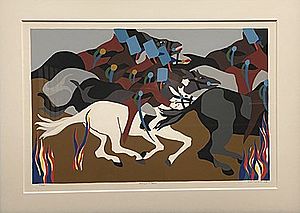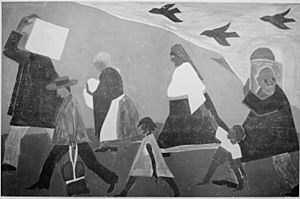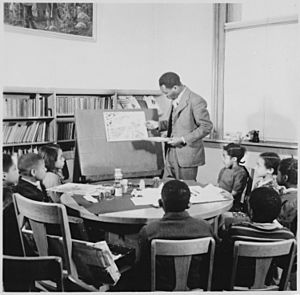Jacob Lawrence facts for kids
Quick facts for kids
Jacob Lawrence
|
|
|---|---|

Jacob Lawrence in 1941
|
|
| Born | September 7, 1917 |
| Died | June 9, 2000 (aged 82) |
| Nationality | American |
| Education | Harlem Community Art Center |
| Known for | Paintings portraying African-American life |
|
Notable work
|
Migration Series |
Jacob Armstead Lawrence (born September 7, 1917 – died June 9, 2000) was an American painter. He was famous for showing African-American history and daily life in his art. Lawrence called his style "dynamic cubism", which means he used strong, sharp shapes and colors. He said his art was inspired by the vibrant shapes and colors he saw in Harlem, New York, not just French art. He used dark colors next to bright ones to bring the African-American experience to life. He also taught art for 16 years as a professor at the University of Washington.
Lawrence is one of the most well-known African-American painters of the 1900s. He was known for his modern pictures of everyday life and stories from African-American history. When he was only 23, he became famous across the country for his 60-panel art series called The Migration Series. This series showed the Great Migration, which was when many African Americans moved from the rural South to cities in the North. This amazing series was bought by two museums together: the Phillips Collection in Washington, D.C., and the Museum of Modern Art (MoMA) in New York. Lawrence's paintings are now in many museums, including the Philadelphia Museum of Art, the Whitney Museum, the Metropolitan Museum of Art, and the Brooklyn Museum. His 1947 painting The Builders even hangs in the White House.
Contents
Jacob Lawrence's Life Story
Early Years and Art Training
Jacob Lawrence was born on September 7, 1917, in Atlantic City, New Jersey. His parents had moved there from the southern United States. In 1924, his parents divorced. His mother placed him and his two younger siblings in foster care in Philadelphia. When he was 13, he and his siblings moved to New York City and reunited with their mother in Harlem.
Lawrence started learning about art soon after. His mother enrolled him in after-school art classes at a place called Utopia Children's Center in Harlem. She wanted to keep him busy. Young Jacob often drew patterns with crayons, sometimes copying the designs from his mother's carpets.
After leaving school at 16, Lawrence worked in a laundromat and a printing shop. But he kept making art. He took classes at the Harlem Art Workshop, taught by the famous African-American artist Charles Alston. Alston encouraged him to go to the Harlem Community Art Center, which was led by the sculptor Augusta Savage. Savage helped Lawrence get a scholarship to the American Artists School. She also helped him get a paid job with the Works Progress Administration. This program was created during the Great Depression by President Franklin D. Roosevelt to help people find work.
Lawrence continued his art studies with Alston and Henry Bannarn, another artist from the Harlem Renaissance. The Harlem community was very important for training many Black artists in the United States. Lawrence was one of the first artists to be trained by and within the African-American community in Harlem. Throughout his long career, Lawrence focused on showing the history and challenges faced by African Americans.
The lively and sometimes tough parts of Harlem during the Great Depression inspired Lawrence. He also loved the colors, shapes, and patterns he saw inside people's homes. He once said that people of his mother's generation would decorate their homes with all sorts of colors, making him think of the artist Matisse. Lawrence used water-based paints for all his work. He became known for his exciting pictures of both modern African-American city life and historical events. He showed these scenes using clear shapes, bright colors, strong patterns, and expressive body language.
Art Career and Famous Works

Early in his career, Lawrence developed his unique style: creating series of paintings that told a story. When he was just 21, his series of 41 paintings about the Haitian general Toussaint L’Ouverture was shown at the Baltimore Museum of Art. Toussaint L’Ouverture led a slave revolution that helped Haiti gain independence. After this, Lawrence created series about the lives of Harriet Tubman (1938–39) and Frederick Douglass (1939–40).
His teacher Charles Alston wrote about Lawrence's work in 1938. He said Lawrence had "miraculously escaped" common art ideas and followed his own path. Alston praised Lawrence's use of color and said he showed the "vitality, seriousness and promise of a new... generation of Negro artists."
On July 24, 1941, Lawrence married the painter Gwendolyn Knight. She also studied with Augusta Savage. Gwendolyn helped prepare the panels for his paintings and wrote the captions for his multi-painting works.
The Migration Series
Lawrence finished his 60-panel series called Migration of the Negro (now known as the Migration Series) in 1940–41. This series showed the Great Migration, when hundreds of thousands of African Americans moved from the rural South to northern cities after World War I. Because he used tempera paint, which dries quickly, he planned all 60 paintings first. Then, he would apply one color to all the paintings where it was needed, to make sure the colors matched. Only then would he move on to the next color.
The series was shown at the Downtown Gallery in New York, making him the first African-American artist to be represented by a New York gallery. This brought him national fame. Parts of the series were even shown in Fortune magazine in 1941. The entire series was bought by the Phillips Collection in Washington, D.C., and the Museum of Modern Art in New York. The Phillips Collection has the odd-numbered paintings, and MoMA has the even-numbered ones.
In 1941–42, Lawrence created another series of 22 panels about the abolitionist John Brown. Later, in 1977, Lawrence recreated these paintings as silkscreen prints because the originals were too old to display.
In 1943, a writer for The New York Times praised Lawrence's next series of 30 images about life in Harlem. He called it "an amazing social document" and said Lawrence's colors were "fittingly vivid."
World War II and Lost Art
In October 1943, during World War II, Lawrence joined the United States Coast Guard. He worked as a public affairs specialist on the USCGC Sea Cloud, which had the first racially mixed crew. He kept painting and sketching while in the Coast Guard, showing what war was like around the world. He made 48 paintings during this time, but sadly, all of them have been lost. He reached the rank of petty officer third class.
In 1944, the Museum of Modern Art (MoMA) showed all 60 Migration panels plus 8 paintings Lawrence made on the Sea Cloud. The Coast Guard sent these eight paintings to exhibits across the United States. But during the changes after the war, these paintings went missing.
After the War
In 1945, Lawrence received a special award from the Guggenheim Foundation for his art. In 1946, he was invited to teach at the Black Mountain College summer art program.
When he returned to New York, Lawrence continued to paint but became depressed. In 1949, he stayed at Hillside Hospital in Queens for eleven months. While there, he created his "Hospital Series," which showed the emotional states of people in the hospital.
Between 1954 and 1956, Lawrence created a 30-panel series called "Struggle: From the History of the American People." This series showed historical scenes from 1775 to 1817. It included references to current events and sometimes explored less-known parts of American history. For example, it showed a woman, Margaret Cochran Corbin, fighting in combat, and the wall built by enslaved Black people that protected American forces at the Battle of New Orleans. Instead of regular titles, Lawrence labeled each panel with a quote. Three panels from this series are lost, but three others were found in 2017, 2020, and 2021.
In 1960, the Brooklyn Museum of Art held a special exhibition of his work. In 1969, he was one of 200 Black artists featured in a major show in Philadelphia.
Books and Illustrations
Lawrence also illustrated several books for children. His book Harriet and the Promised Land came out in 1968. It used his paintings to tell the story of Harriet Tubman. The New York Times called it one of the year's best illustrated books. Two similar books followed, based on his John Brown and Great Migration series. Lawrence also created illustrations for 18 of Aesop's Fables in 1970.
Teaching and Later Works
Lawrence taught at several schools, including the New School for Social Research and the Art Students League. In 1970, he became a visiting artist at the University of Washington, and from 1971 to 1986, he was an art professor there.
After moving to Washington state, Lawrence created a series of five paintings about the westward journey of the African-American pioneer George Washington Bush. These paintings are now in the State of Washington History Museum.
He also took on several large art projects. In 1980, he finished Exploration, a 40-foot-long mural made of porcelain on steel. It had 12 panels showing different academic subjects and was installed at Howard University. The Washington Post described it as "enormously sophisticated yet wholly unpretentious."
In 1983, Lawrence produced another series of eight screen prints called the Hiroshima Series. He chose to illustrate a new edition of John Hershey's book Hiroshima (1946). In these prints, he used abstract shapes to show survivors at the moment of the atomic bombing, surrounded by destruction.
Lawrence's painting Theater was commissioned by the University of Washington in 1985 and is in the main lobby of the Meany Hall for the Performing Arts.
Last Years and Passing
The Whitney Museum of American Art held a large exhibition of Lawrence's entire career in 1974, and the Seattle Art Museum did the same in 1986.
In 1999, he and his wife started the Jacob and Gwendolyn Lawrence Foundation. This foundation helps create, show, and study American art, especially works by African-American artists. It also keeps an archive of nearly a thousand images of their art.
Lawrence continued to paint until a few weeks before he passed away from lung cancer on June 9, 2000. He was 82 years old.
Personal Life
His wife, Gwendolyn Knight, lived until 2005, passing away at the age of 91.
Awards and Honors
Jacob Lawrence received many awards and honors for his contributions to art:
- 1945: Awarded a fellowship by the Guggenheim Foundation.
- 1970: Received the Spingarn Medal from the NAACP for his amazing achievements.
- 1971: Became an associate member of the National Academy of Design.
- 1978: Elected a full member of the National Academy of Design.
- 1983: Elected a member of the American Academy of Arts and Letters.
- 1990: Awarded the U.S. National Medal of Arts, one of the highest honors for artists in the United States.
- 1995: Elected a fellow of the American Academy of Arts and Sciences.
- 1996: Received the Algur H. Meadows Award for Excellence from Southern Methodist University.
- 1998: Awarded The Washington Medal of Merit, the highest honor in Washington state.
He also received honorary degrees from 18 different universities, including Harvard, Yale, and New York University.
Legacy and Impact
The New York Times called Jacob Lawrence "one of America's leading modern figurative painters" and "among the most impassioned visual chroniclers of the African-American experience." Shortly before he passed away, Lawrence said that for him, a painting should have "universality, clarity and strength." He believed it should be beautiful and understood by everyone.
A special exhibition of Lawrence's work, planned before his death, opened in 2001 at the Phillips Collection. It then traveled to other major museums across the United States. This exhibit came out around the same time as a book called Jacob Lawrence: Paintings, Drawings, and Murals (1935-1999), A Catalogue Raisonne, which listed all his known works. His last public art project, a mosaic mural called New York in Transit made of Murano glass, was installed in October 2001 in the Times Square subway station in New York City.
In 2005, Lawrence's 1948 drawing Dixie Café was chosen to be part of a U.S. postage stamp panel. This panel honored important moments of the Civil Rights Movement and was called To Form A More Perfect Union.
In May 2007, the White House Historical Association bought Lawrence's painting The Builders (1947) for $2.5 million. This painting has been displayed in the White House Green Room since 2009.
The Seattle Art Museum offers a special award called the Gwendolyn Knight and Jacob Lawrence Fellowship. This award supports artists whose work shows the Lawrences' dedication to artistic excellence, education, and mentorship. The Jacob Lawrence Gallery at the University of Washington School of Art + Art History + Design also offers an annual Jacob Lawrence Legacy Residency.
His art is part of the permanent collections of many museums around the world, including the British Museum, the Metropolitan Museum of Art, the Museum of Modern Art, the Whitney Museum, the Phillips Collection, the Brooklyn Museum, the National Gallery of Art, the Art Institute Chicago, the Seattle Art Museum, the Philadelphia Museum of Art, and the Musei Vaticani.
See also
 In Spanish: Jacob Lawrence para niños
In Spanish: Jacob Lawrence para niños



